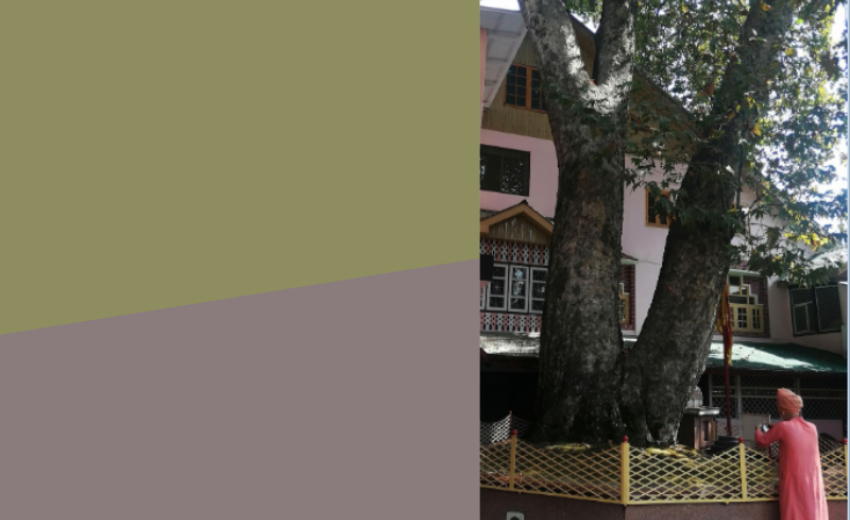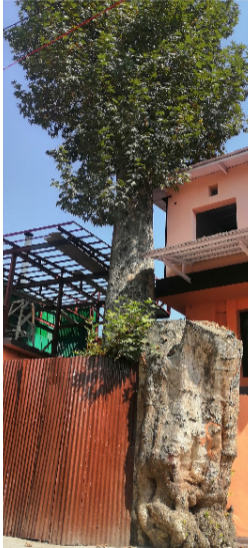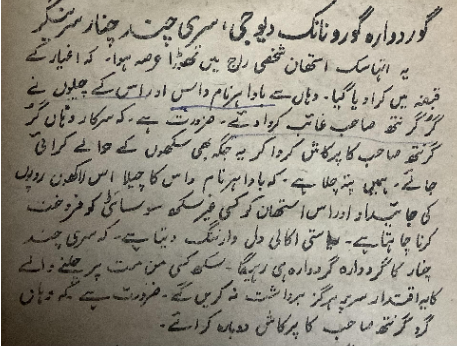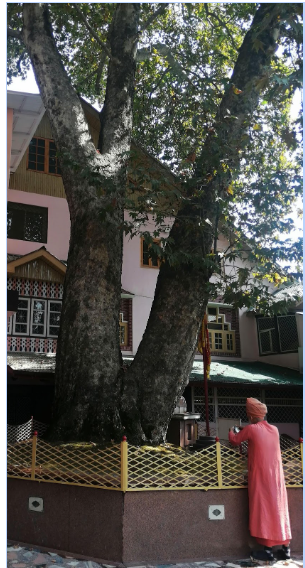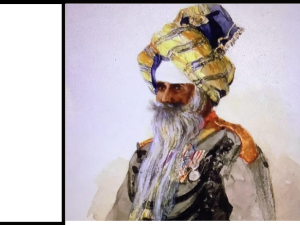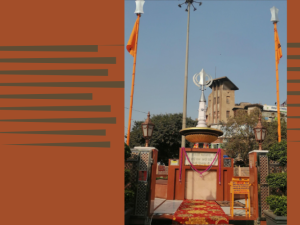Abstract : Baba Sri Chand Ji (1494-1629), the elder son of Guru Nanak Dev Ji, occupies a unique position in Sikh history as the founder of the Udasi sect, a spiritual path rooted in detachment from worldly desires. His life, marked by miraculous occurrences, profound wisdom, and an unwavering commitment to peace and unity, particularly in regions such as Kashmir, continues to resonate with spiritual seekers across different faiths. This paper explores the rich legacy of Baba Sri Chand Ji in Kashmir, focusing on his interactions with notable historical figures such as Emperor Jahangir and Nawab Yakub Khan. The study highlights his contributions to fostering harmony between Hindus and Muslims and his lasting spiritual impact on Kashmir, symbolized by the Sri Chand Chinar, a monument of peace that endures in Srinagar.
Introduction
The life of Baba Sri Chand Ji is a remarkable chapter in Sikhism and Indian spirituality. Born in 1494 to Mata Sulakhani Ji and Guru Nanak Dev Ji, the founder of Sikhism, Baba Sri Chand Ji diverged from the traditional path of household life to lead an ascetic existence. He established the Udasi sect, a movement centered on renunciation and deep meditation, and became known for his miraculous feats and deep spiritual wisdom. His presence in Kashmir, a region fraught with communal tensions during his time, offers profound lessons on the power of spiritual leadership in fostering peace and unity.
(Chinar under which Guru Nanak Dev ji and Baba Sri Chand ji rested)
This paper delves into the spiritual and historical significance of Baba Sri Chand Ji's activities in Kashmir, his interactions with both common people and rulers, and his influence on the spiritual landscape of the region. Through an examination of historical texts and oral traditions, this study presents a scholarly account of Baba Sri Chand Ji's enduring legacy in Kashmir.
Historic Context -In the historical context of the Sikh religious and cultural presence in Kashmir, the site under the Chinar tree, where Guru Nanak Dev Ji is said to have sat, holds profound significance. Originally referred to as Chinar Baba Nanak, the site was later renamed Chinar Baba Sri Chand Ji by Baba Sri Chand Ji's disciples, following his significant visit, reflecting his profound influence and enduring legacy in the region. According to tradition, Guru Nanak Dev Ji visited this area during his travels, and his presence sanctified the site, near which an old well of sweet water existed. Before the Sikh rule, Gurdwara Guru Nanak Dev Ji, Sri Chand Chinar, Srinagar, was established at this very place to commemorate his visit.During the time of Jabarkhan and other Afghani rulers, the management of Gurdwara was auspicious . During Sikh rule Gurdwara was renovated during Sardar Hari Singh Nalwa’s governorship.
In a series of concerted efforts characterized by numerous meetings and extensive missionary work, revered Gursikhs such as S. Harnam Singh Kharjakhia and S. Mehar Singh Rains of Kanahama played a pivotal role in establishing the Sri Guru Singh Sabha at Gurdwara Guru Nanak Dev Ji, located at Sri Chand Chinar. These endeavors were marked by the active participation of several distinguished Sikh figures, including Sardar Ganda Singh, Sardar Attar Singh Johar, Sardar Magar Singh, Sardar Gulab Singh, and Sardar Mool Singh. Following a consensus reached through Gurmata, these prominent Sikhs undertook the significant task of acquiring land, which ultimately led to the foundation of Gurdwara Singh Sabha at Amirakadal in Srinagar. This effort was emblematic of the community’s commitment to upholding and propagating the tenets of Sikhism in the region.
However, during the Dogra rule, the sanctity of this site was at stake . A significant event occurred when Guru Granth Sahib was reportedly removed by Bawa Harnam Das and his disciples, leading to the establishment of a Hindu temple on the site where the Gurdwara once stood. This act caused great distress among the Sikh community, who regarded the removal of Guru Granth Sahib and the transformation of the Gurdwara into a temple as an affront to their religious and cultural heritage.
Sardar Sant Singh Tegh, the President of the All J&K State Akali Dal, highlighted this issue in his address in the Third Akali Conference held on 2-3 June 1956 at Srinagar, where he distributed a urdu booklet in which the plight of this Gurdwara highlighted .
In this speech, Sardar Sant Singh Tegh emphasized the historical significance of the Gurdwara Guru Nanak Dev Ji, Sri Chand Chinar Srinagar and the need to restore its rightful status as a Sikh place of worship. He condemned the actions of Bawa Harnam Das and his followers, who not only removed the Guru Granth Sahib but were also reportedly planning to sell the land for a significant sum of money, with the intention of handing the site over to a non-Sikh organization.The Rayasti Akali Dal issued a stern warning that the Gurdwara should remain a Gurdwara and that any attempts to transform it into a different type of religious or private site would not be tolerated. The speech underscores the Sikh community’s demand for the restoration of the Gurdwara’s sanctity through the reinstallation of the Guru Granth Sahib and its return to the Sikh fold. This event exemplifies the tensions between religious communities and highlights the importance of historical preservation of religious sites. It also reflects the resilience of the Sikh community in safeguarding their sacred spaces and heritage, despite external pressures and challenges during various political regimes.
Baba Sri Chand Ji and His Early Life
Born in Sultanpur Lodhi, Punjab, Baba Sri Chand Ji displayed an inclination toward spirituality from an early age. At the tender age of eleven, he traveled to Kashmir, where he studied Sanskrit and engaged in yogic practices under the guidance of Pandit Purushottam Kaul and Avanash Muni. His choice to pursue a life of renunciation rather than follow in his father’s footsteps as a Guru led him to establish the Udasi sect, which emphasized detachment from materialism and worldly affairs.
His deep understanding of spirituality allowed him to gather disciples from various parts of India, spreading his teachings far and wide. Despite his ascetic path, Baba Sri Chand Ji remained connected with the Sikh Gurus and played a significant role in maintaining ties with his father’s spiritual lineage. His life exemplified a balance between personal renunciation and social engagement, particularly in his efforts to promote peace in conflict-ridden regions like Kashmir.
Kashmir: A Land of Peaceful Intervention
Kashmir, during the 16th and 17th centuries, was a region marked by religious tensions between Hindus and Muslims. Baba Sri Chand Ji's arrival in the region brought a calming influence. One of the most notable incidents in Kashmir involved his encounter with Nawab Yakub Khan, whose anger had exacerbated communal tensions. In a dramatic display of spiritual power, Baba Sri Chand Ji extinguished a burning stick and planted it in the ground, where it miraculously grew into a Chinar tree.
(Chinar Planted by Baba Sri Chand ji )
This act symbolized the extinguishing of anger and the establishment of peace in the region. The Sri Chand Chinar, which still stands in Srinagar today, serves as a testament to his message of harmony. The incident with Nawab Yakub Khan is more than just a miracle ,it is a profound metaphor for the transformative power of spirituality in cooling the fires of anger and division. By planting the Chinar tree, Baba Sri Chand Ji demonstrated that spiritual wisdom transcends sectarian divides and can unite people across religious lines. His presence in Kashmir thus became a beacon of hope for both Hindus and Muslims during a time of strife.
Miracles and Encounters with Jahangir
Another significant episode in Baba Sri Chand Ji's life was his interaction with Emperor Jahangir. Known for his engagement with spiritual leaders, Jahangir invited Baba Sri Chand Ji to his court, offering a royal elephant to transport him. In a moment that highlighted the folly of worldly power, Baba Sri Chand Ji remarked that the elephant would not be able to carry even his blanket. To the astonishment of the emperor's courtiers, the elephant collapsed under the weight of the blanket. Through this miraculous act, Baba Ji subtly conveyed that true power lies in spirituality, not in temporal authority. This encounter reinforced Baba Ji's reputation as a spiritual figure who transcended political and religious boundaries. His influence reached beyond the Sikh community, touching the hearts of people from various faiths, including the ruling Mughal elite.
The Udasi Sect and its Legacy
The Udasi sect founded by Baba Sri Chand Ji became a prominent spiritual movement, with followers who practiced renunciation and traveled extensively to spread the teachings of Guru Nanak Dev Ji .The Udasis played a crucial role in preserving Sikh scriptures and spreading the message of the Guru throughout India. Baba Sri Chand Ji's choice of asceticism did not distance him from the Sikh tradition; rather, it complemented the efforts of the Guru by reaching those who were inclined towards a life of detachment and meditation.
(Historic Well) In Kashmir, the Udasis established several centers of spiritual learning and practice. These centers became hubs for dialogue between different religious communities, contributing to the region's rich spiritual heritage. The enduring presence of the Udasi sect in Kashmir is a testament to Baba Sri Chand Ji's far-reaching influence. Baba Sri Chand Ji believed that Sri Guru Nanak Dev Ji was the Divine light of the Almighty and in Praise of the Eternal Glory of Sri Guru Nanak Sahib he uttered AARTA.
Conclusion
Baba Sri Chand Ji remains a towering figure in Indian spiritual history, not only for his role as the founder of the Udasi sect but also for his contributions to peace and unity, particularly in Kashmir. His life, marked by miraculous acts and profound spiritual insight, serves as a reminder of the power of detachment, humility, and compassion in addressing the conflicts of the world. The Sri Chand Chinar in Srinagar stands as a living monument to his legacy, symbolizing the cooling of anger and the nurturing of peace. In a world increasingly divided along religious and cultural lines, Baba Sri Chand Ji's message of unity and his ability to transcend these divisions offer valuable lessons for contemporary society. His legacy in Kashmir, where he fostered peace between Hindus and Muslims, continues to inspire generations, reaffirming the timeless nature of spiritual wisdom.
Bibliography
Harbans Singh.(1969) _Guru Nanak and Origins of the Sikh Faith_. Bombay.
Harbans Singh.(1996 ) _The Encyclopedia of Sikhism_. Patiala.
Macauliffe, Max Arthur(1909). _The Sikh Religion_,Oxford.
Nārā, Īshar Singh.(1975) _Itihas Bābā Sri Chand Ji Sahib ate Udāsīn Sampardāi ,Amritsar.
Parmu,R K (1977)—A History of Sikh Rule in Kashmir,Deptt of Education,J&K
Randhir Singh (1959) _Udāsī Sikhān di Vithiā_. Amritsar.
Sarna,Jasbir Singh (1997)— Jammu Kashmir de Sikh Tawarikh, Kashmir
Sarna,Jasbir Singh (2023)— The Sikhs in Jammu and Kashmir, J&K.
Tegh,Sant Singh (1956) —presidential Address (Urdu), Srinagar, Kashmir
